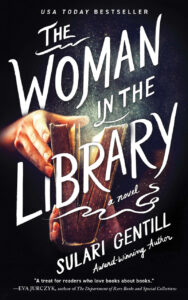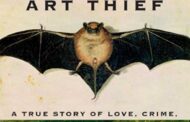Book Short
‘The Woman in the Library’
by Sulari Gentill
Review by Stephanie Miller
A woman in Australia named Hannah is writing a novel about an Australian woman named Freddie (short for Winifred), who is writing a novel during a fellowship grant year in Boston about an Australian writer falling in love with a fellow writer named Cain–who may be a murderer. Amid the chapters of Hannah’s novel about Freddie we read one-sided email correspondence between Hannah and a fan/fellow writer named Leo, who lives in Boston and offers to provide local color… And who may be a murderer.

Got that?
I hope not. Because exploring the twists and turns of this psychological thriller cum mystery novel is a not-to-be missed, wonderful experience.
A sophisticated, multi-layered novel
I found it on the “Featured Fiction” table of our splendid Portland Public Library. This is ironic (and appropriate for this twisty tale) because the Boston Public Library and its magnificent reading room is the opening murder scene for Freddie’s novel. She is inspired by her real life fast friendship with three others sitting together when a horrible, ragged death scream echoes around them. It’s a bonding moment among random strangers. Or, it was staged by the murderer to provide an alibi.
It’s a bit of a heart-pounding page turner as the psychological threats to both Hannah and Freddie escalate. I love the construct of it. The author describes it in an interview as, “A story within a story wrapped up in a correspondence.” We only hear Hannah’s voice through her novel—which she is sending progressively to Leo for fact checking — and in his email replies to her. Is Hannah writing this novel in response to the research Leo provides? Is Leo’s generous support a guise for stalking her? A mask for his psychotic tendencies? Or, are they simply writers using whatever life offers as material for their work?
There is a crashing crescendo that does what the best mystery novels do—reveal the last person I suspected as the murderer. There is a delightful ending paragraph that tosses in one final twist in the tale, leaving us hanging as to where this story within a story will really end.
The prolific Sulari Gentill
“Woman in the Library” was my introduction to this award winning author. But it turns out Gentill is prolific, with ten Rowland Sinclair WW2 mysteries and several other series and standalone novels. The blurbs on this edition are written by well known mystery writers—so there is definitely more to explore.
I picked it up because I’m a sucker for any book about books. I’m glad I did because it was one I’d like to read again. I’m sure I missed some nuance in this sophisticated, multi-layered novel that explores friendship, second chances, trust, and the power of well written words.
Micro Shorts
‘American Daughters,’ by Maurice Carlos Ruffin
The cover shows a Black woman holding a silver tray of decanted port and fancy flute glasses. Her face turns away from us: determined, intelligent, and proud. It’s a good cover choice, as this novel is an unexpected take on the life of enslaved women in America, giving them a power and purpose that will inspire and shake you.
There is a somewhat confusing construct of a researcher looking back from the far future trying to piece together what is authentic from scraps of voices that were erased by the owners of “slave labor camps, also known as plantations” and their racist descendants. The story follows Ady, enslaved, and Lenore, a free colored woman, and their fellow clandestine operators of The Daughters — an abolitionist insurrectionist group. They spy for the North, sabotage the Confederate cause in small and large ways, and circumvent the proper protection of the city. All of which paves the way for New Orleans to be taken over by Union soldiers without a fight.
Their lives are not glamorous or safe. Ady is beaten and raped repeatedly by her master, who perversely insists she call him “Father.” Lenore runs her own business, but is suppressed by her father and society’s unwillingness to let colored people live with dignity.
The novel’s claim that this story is pieced together by future historians explains the disjointed narrative, how Ady gets away with her double life as an employee of Lenore’s boardinghouse, and some of the inconsistent behavior of the slavers. Despite that, I found the core premise plausible. Specifically speaking, enslaved and oppressed Black women formed their own loosely organized sabotage efforts to honor the struggles of their mothers and create a better world for their daughters.
‘Yellow Bird,’ by Sierra Crane Murdoch
When Lissa Yellow Bird returned from prison to the Fort Berthold Indian Reservation in North Dakota, she found her tribal home transformed by the oil boom. Corporate interests and corruption have resulted in a surge of violence and addiction. She becomes obsessed with learning about the lack of interest and misdirection around the death of a young white oil worker, Kristopher “KC” Clarke. Lissa assures his mother that she will research the incident and learn what can be learned. In this well-documented nonfiction account based on years of investigative journalism, Murdoch, who is white, tells how Lissa’s fanatical but respectful search brings closure to Clarke’s family and healing to Fort Berthold. Lissa’s story — which is KC’s story, too — is told with dignity and honor.
‘Home Now: How 6000 Refugees Transformed an American Town,’ by Cynthia Anderson (MAINE AUTHOR)
When the mill jobs disappeared, the story of Lewiston, Maine twisted in a new direction: becoming a hub for thousands of African immigrants. Chronicling this transition from 2016 through 2019, when Lewiston became one of the most Muslim towns in America, Anderson provides a journalistic reveal of the racism, and anti-Muslim and cultural clashes of her home town in transition. Through threads of people calling Lewiston home — long time residents and New Mainers alike — she also shares beautiful but hard wrought stories of acceptance, love, joy, and hope, as refugees and asylum seekers make Maine their new home, collaborating, supporting, and advocating for rights and understanding.
Midway through the book, she shares: “What I sensed overall was longing for an earlier, thriving Lewiston. People wanted Lewiston’s glory days, even if they were too young to remember them. … More than anything they wanted the pride [of a company town where hard work pretty much guaranteed a good life].”
“But here’s the thing. You can view the arrival of Muslim and other African newcomers as part of Lewiston’s decline. Or you can see them as the closest thing the city has to a solution.” A lot has happened in Lewiston—and in our national politics—since 2019.
“Home Now” remains relevant as a window into the struggles of New Mainers to join our society, adapt to and influence our culture, build shared economic wealth, and call Maine home.





